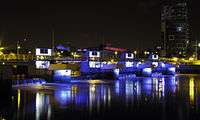Lagan Weir
The Lagan Weir, is located in Belfast, Northern Ireland and crosses the River Lagan between the Queen Elizabeth Bridge and the M3 cross-harbour bridge. Without the weir, the river would be subject to tidal fluctuations. Prior to the building of the weir, low tide would expose mudflats, which were unsightly and emitted a strong odour, particularly in the summer months. The Lagan Weir was the seen by the Laganside Corporation as a catalyst for its redevelopment projects and was judged to be the "centrepiece" of that effort.[1][2]

Introduction
The Lagan Weir, completed in 1994 at a cost of £14m, is located in Belfast, Northern Ireland and crosses the River Lagan between the Queen Elizabeth Bridge and the M3 cross-harbour bridge.[1] The project was jointly funded by the Laganside Corporation and the European Commission and designed by Ferguson and McIlveen and constructed by Charles Brand Ltd.[3][4]
Planning for the weir commenced as early as 1988.[5] The Prince of Wales was involved in the ceremonial setting of the first pile for the weir on 7 March 1991.[6] The floating crane Mersey Mammoth lifted the five 32 tonne weir gates into position in May 1992. The weir gates measure 18 metres by 5 metres and were manufactured by Harland & Wolff.[7][1] The Weir was officially opened in March 1994.[1]
The project included the "Lagan Lookout" on the Donegall Quay side of the river. This houses a visitors centre which has an exhibition to provide information on the function of the weir and the history of the River Lagan. The weir gate control centre, security, CCTV system and welfare facilities for River Management personnel are located on the ground floor. Equipment storage is located in the basement.
The Lagan Weir consists of five weir gates and four intermediate gatehouses. A tunnel traverses under the River Lagan, which connects to both quaysides and to each of the gatehouses. Primarily, this provides access to the gatehouses for maintaining the weir gate motors.
Weir Operations
The five weir gates can each be operated independently. They are usually raised as the tide retreats in order to keep the river at a specific impoundment level. The gate operations are controlled by the River Manager. Without the weir, the river would be subject to tidal fluctuations. The tidal range is typically up to three metres between high and low tide, but the maximum tidal range can be as much as four metres.[8] Prior to the building of the weir, low tide would expose mudflats, which were unsightly and emitted a strong odour, particularly in the summer months. On occasion, at high tide, the weir can operate as a barrage. If the river level is too high this can have such negative effects as causing erosion of the river banks, reduce air draft for vessels needing to pass under any of the river's road bridges and in extreme cases, increase the risk of flooding to low areas.
Benefits after Construction of the Weir
Construction of the weir, installation of an underwater aeration system and maintenance dredging has led to environmental improvements in terms of water quality and biodiversity.[9] Dredging was carried out at the same time as the construction of the weir. Subsequent dredging was completed in 2010/2011 and 2019/2020.[9][10] Development along the riverside has included construction of new residential towers, commercial and retail blocks, restaurants, and improved public towpaths.
Date published:
Pedestrian Footbridge
A pedestrian footbridge was constructed over the weir and connects Donegall Quay with Queen's Quay. The original bridge, which was narrow and required spiral access ramps at either end, was located above the weir gates and supported by the weir gatehouse structures. This was removed in 2014 to allow the construction a new structure, which provides access for both cyclists and pedestrians. The new bridge was erected by Graham Construction at a cost of £5m and is approximately 8 meters wide at its widest point.[11]
| Next crossing upstream | River Lagan | Next crossing downstream |
| Queen Elizabeth II Bridge | Lagan Weir | Dargan Bridge |
References
- Moritary, Gerry (25 March 1994). "£14m weir could open floodgates for Lagan growth". The Irish Times.
- Coone, Tim (21 September 1992). "Survey of Northern Ireland". Financial Times. London.
- Cowan, Rosie (4 March 1997). "Architects' green belter!". Belfast Telegraph. Belfast.
- "Stage set for career women awards". Belfast Telegraph. 3 November 1998.
- Strafford, Peter (8 November 1988). "Shoppers flock towards a city springing back to life". London.
- Graham, Ian; Henderson, Deric (7 March 1991). "Prince Defies Security Leak for Belfast Walkabout". The Press Association.
- "Mammoth Task at the River". Evening Standard. London. 15 May 1992.
- "Tide Times and Tide Chart for Belfast". www.tide-forecast.com.
- "Dredge plans for "smelly" Lagan". BBC News. 17 September 2010. Retrieved 20 June 2020.
- "Major project to dredge the River Lagan underway" (Press release). Department for Communities. 17 October 2019. Retrieved 20 June 2020.
- "£5m River Lagan pedestrian bridge opens in Belfast". Belfast Telegraph. Belfast. 30 June 2015. Retrieved 20 June 2020.
External links
| Wikimedia Commons has media related to Lagan Weir. |